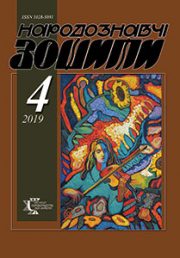The Ethnology Notebooks. 2022. № 5 (167), 1185—1193
UDK 7.034.7:75.03(43)”17/18″
DOI https://doi.org/10.15407/nz2022.05.1185
LYSUN Yaryna
- ORCID ID: https://orcid.org/0000-0002-5620-2889
- researcher,
- Lviv National Academy of Arts,
- 38, Kubiyovycha str., 79011, Lviv, Ukraine,
- Contacts: e-mail: yarynalysun@gmail.com
Abstract. The article examines the process of dissemination, adaptation and interpretation of the traditions of Western European monumental painting of the Baroque era in the art of Central European countries.
The purpose of the article is to analyze the processes of spreading the artistic traditions of the Western European monumental painting of the Baroque era in the countries of Central Europe on the example of the artistic realizations of prominent representatives of the monumental painting of these countries.
The object of the study is the wall painting of the churches of the countries of Western and Central Europe of the XVII—XVIII centuries.
The subject of the study is the reflection of the artistic traditions of the Western European Baroque in the wall paintings of the churches of the countries of Central Europe.
The results of the study indicate that the art of the countries of Central Europe during the XVII—XVIII centuries developed in close interaction with Western European art. At the same time, along with imitating the works of Western European masters, interpretation of these traditions took place at local levels, and national art schools with their own artistic and stylistic features were formed accordingly.
Research methodology. This study is based on art history methods of stylistic and comparative analysis, as well as general scientific methods of analysis and synthesis.
Keywords: murals, techniques and methods of illusionistic (trompe-l’oeil) painting, decorative-ornamental and perspective-realistic directions of wall painting, blinding, artistic and stylistic features, baroque, rococo, classicism, artistic traditions of Western and Central European countries.
Received 8.10.2022
REFERENCES
- Krasny, P. (2005). Lviv artistic milieum in the face of the idea of a symbiosis of arts in the decor and furnishing of sacred interiors (1730—1780). Almanac of Art History (Vol. 30, pp. 147—189). Warsaw: Neriton [in Polish].
- Barok 1580—1750. Retrieved from: http://www.plastyczniak.opole.pl/static/upload/dokumenty/sztuka-barokowa-w-europie.pdf (Last accessed: 02.10.2022) [in Polish].
- Baroque monumental painting. Retrieved from: http://bibliograph.com.ua/avanta/5.htm (Last accessed: 10.06.2022) [in Ukrainian].
- Hornung, Z. (1935). Stanislaw Stroinski 1719—1802. Monographic essay with particular emphasis on the artist’s activity in the field of wall painting. The works of the history and art and culture section of the Scientific Society in Lviv (Vol. 2). Lviv [in Polish].
- Plafonds and vaults. Retrieved from: www.bibliotekar.ru/slovar-impr3/179.htm (Last accessed: 03.07.2020) [in Russian].
- Vipper, B.R. (1966). The problem of realism in Italian painting of the 17th—18th centuries. Moscow: Iskusstvo [in Russian].
- Chmelinova, K. (2017). Baroque treasures. Between Bratislava and Krakow. Krakow: National Museum in Krakow [in Polish].
- Hammer, H. (1912). The development of baroque ceiling painting in Tyrol. Strasbourg: Heitz & Mundel [in German].
- Tintelnot, H. (1941). Johann Oswald Harms. A North German Baroque painter. Journal of the German Association for Art History, 8 (Issue 3/4, pp. 245—260) [in German].
- Gerke, F. (1950). The frescoes by Franz Anton Maulbertsch in the parish church in Sumeg. Wiesbaden: Academy of Sciences and Literature [in German].
- Rohlig, U. (1949). The ceiling frescoes by Johan Baptist Zimmermann. Munich [in German].
- Razdol’skaja, V.I. (Ed.). (1988). Foreign countries art history of the 17th—18th centuries. Moscow: Izobrazitel’noe iskusstvo [in Russian].
- Bazhenova, O.D. (2007). Radziwill Nesvizh. Frescoes in the Church of the God’s Body. Minsk: Charvest [in Russian].
- Karpowicz, M. (1988). Baroque in Poland. Warsaw: Arkady [in Polish].
- Kowalczyk, J. (1975). Andrea Pozzo and late baroque in Poland. Pt. I. Treatise and altars. Art History Bulletin, 2 (Vol. 37, pp. 162—178). Warsaw: Institute of Art of the Polish Academy of Sciences [in Polish].
- Mankowski, T. (1954). Giuseppe Carlo Pedretti and his Polish student. Art History Bulletin, 2 (Vol. 16, pp. 251—257). Warsaw: Institute of Art of the Polish Academy of Sciences [in Polish].
- Beskorsa, V.M. (2005). Baroque transformation in the artistic culture of Ukraine in the 17th—18th centuries. (Extended abstract of candidate’s thesis). Kharkiv [in Ukrainian]
- Papee, F. (1924). History outline of Lviv. Lviv; Warsaw: Ksiaznica Polska [in Polish].




